Last Updated on January 19, 2024 by Greg Gillson
Would you like to set up a bird feeding station in Michigan this winter? Many find great joy from feeding birds. Perhaps you have some questions about what foods to offer and what birds to expect. This article is for you!
This article tells why and how to feed winter birds in Michigan. It includes photos and descriptions of some of the most-likely feeder birds in Michigan. It tells what kinds of foods each species likes and what kind of feeder each bird prefers.
Winters in Michigan are very cold. There are many consecutive days in winter where the temperature does not reach above freezing. Snow averages 40-120 inches per year, depending upon what part of the state you live in.
That means that winter bird feeding must take into account that natural foods may be buried in snow for much of the winter. The birds really will appreciate the food you offer! The good news is that you should easily be able to attract lots of birds!
Why feed winter birds in Michigan?
As you’ll see below, there are many birds in Michigan that come to feeders. It is so much fun to have feeders overflowing with so many different types of birds!
Feeding winter birds in Michigan can actually make a life-and-death difference during those especially long cold spells and periods of deep snow. At such times backyard bird feeders do more than just provide an added supplement to natural foods. Some birds would probably not survive winter without some help.
It may be that first-year birds benefit the most from bird feeders. These birds are barely 6 months old and have not yet experienced their first winter. Thus, they may not be as experienced at finding food in the winter. Your bird feeder can really help keep them fed and healthy.
Of course, the real reason that we feed birds is for the joy that it gives us. People need the connection with nature that inviting birds to the backyard brings. The same individual birds spend the winter in our backyards, waiting for spring. We become attached to “our” birds. And we feed and take care of them.
This gives us a feeling of being needed. Feeding birds can help us survive the long cold dreary winters!
What birds come to feeders in Michigan in winter?
Michigan is blessed with many birds that visit backyard feeders in winter.
We’ll look at a few of the expected species below. For additional lists and identification of backyard birds throughout the year, see my article The most common backyard birds in Michigan. I’ll link to it again at the end of this article.
Following are photos and descriptions of common birds that will visit your feeders in winter in Michigan. I also tell what kind of food each bird loves and what feeders they prefer to eat from.
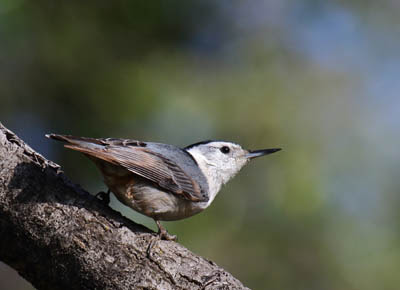 |
| White-breasted Nuthatch Photo by Greg Gillson |
White-breasted Nuthatch:
These are a favorite of backyard bird watchers.
They are common across the United States and southern Canada in deciduous woods and pines. White-breasted Nuthatches are common throughout the year in Michigan.
They are shaped plump with short neck and large head. The bill is long and thin. The tail is so short so as to appear almost absent. The back and wings are blue. The crown is black. The face and underparts are white.
Birds give a nasal yank, yank call.
White-breasted Nuthatches love black oil sunflower seeds that they take from tube feeders.
 |
| Downy Woodpecker Photo by Greg Gillson |
Downy Woodpecker:
Everyone loves woodpeckers!
These small birds are common across most of Alaska, Canada, and the United States, except for treeless grasslands and deserts. Downy Woodpeckers are common throughout the year in Michigan.
They are stocky with a large head. The tail is stiff, short, and pointed. The bill is wedge-shaped, but very dainty in this species. The coloration is black and white striped above with white under parts. Males have a small red spot of feathers at the back of the head.
These birds give a sharp pik call.
Downy Woodpeckers love to eat suet at your feeders. They also eat black oil sunflower seeds and small nuts.
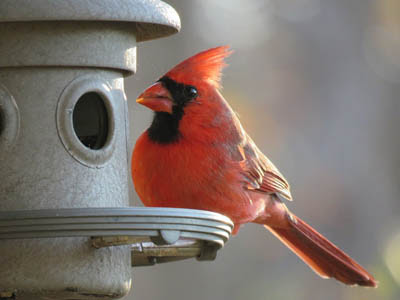 |
| Northern Cardinal Image by GeorgeB2 from Pixabay |
Northern Cardinal:
These popular birds are quite common in deciduous forests in the eastern half of the United States. Northern Cardinals reach their northernmost extent in Michigan where they are resident all year long.
They are fairly large with a long wide tail. The bill is very heavy and conical. The crest is very obvious.
Males are scarlet red throughout with a black face. Females are similar but tan-brown.
These birds sing throughout the year, a whistled birdy-birdy-birdy is a common song.
Northern Cardinals like larger seeds, such as sunflower and safflower seeds. They feed from platform feeders and hopper feeders with wide trays.
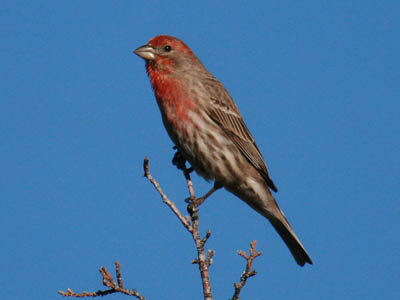 |
| House Finch Photo by Greg Gillson |
House Finch:
These finches are common in backyards and feeders. They occur throughout the United States, southernmost Canada, and well into Mexico. In Michigan House Finches are year-round residents in the Lower Peninsula, rare or absent in the Upper Peninsula.
They are small and fairly long and slim, but with a short neck. They have a conical beak for eating seeds. Birds are pale gray with dusty brown streaks. Males have red on the forehead, upper breast, and rump.
Songs are cheerful and lively. Chirping calls, including a wheet note.
House Finches love black oil sunflowers and eat from tube or hopper feeders.
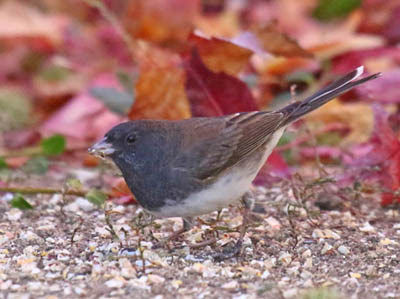 |
| Dark-eyed Junco Photo by Greg Gillson |
Dark-eyed Junco:
This tiny little sparrow visiting your feeder indicates that winter has arrived.
They breed in conifer forests across Alaska and Canada, as well as mountains in the eastern and western United States. Their range in Michigan is complicated. They are summer residents in the Upper Peninsula and northern parts of the Lower Peninsula. and winter visitors in the southern part of the state.
They are plump birds with large heads. They have small conical pink bills. Eastern birds are gray overall with a white belly. They flash white outer tail feathers. Females have some brown on the back and wings.
Common sounds include smacks and twitters. In spring they sing a long musical trill on one pitch.
Dark-eyed Juncos prefer small seeds, such as those found in mixed bird seed. They feed on the ground and on platform feeders.
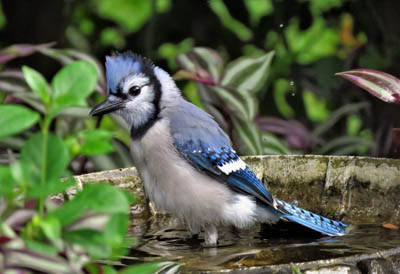 |
| Blue Jay Image by skeeze from Pixabay |
Blue Jay:
These well-known birds are found in deciduous woods east of the Rocky Mountains from southern Canada through the United States. They are year-round residents throughout Michigan.
They are fairly large with a big crested head and round full tail. They are blue above and white or pale gray below. They have black bars and white patches on the wings and tail. A black necklace crosses the upper breast and wraps behind the head.
They give a variety of calls, including a harsh jay jay jay.
Blue Jays are omnivores, eating everything. They may “steal” large quantities of sunflower seeds and fly off and bury them in a food cache for winter. They also like peanuts and tree nuts.
They are large, so like platform feeders and hopper feeders with large trays.
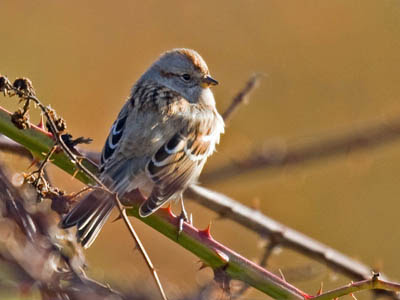 |
| American Tree Sparrow Photo by Greg Gillson |
American Tree Sparrow:
These sparrows of weedy fields often come to bird feeders.
These birds nest at the edge of the Arctic tundra in Alaska and across Canada. In winter they can be found in weedy fields across the northern United States, more commonly east of the Rocky Mountains. In Michigan they migrate through the Upper Peninsula to winter on the Lower Peninsula.
These are small sparrows. They have a small but conical bill, dark on top, pale underneath. They are gray with rusty lateral crown stripe and thin dark line back from the eye. There are two white wing bars on the rusty and black wing. They have a dark spot of feathers in the middle of the breast.
One common call is a musical teedle-eet.
American Tree Sparrows love white proso millet at your feeders. Many mixed bird seed blends contain this seed. They prefer to feed on the ground or on platform feeders.
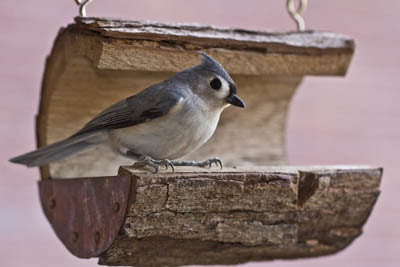 |
| Tufted Titmouse Image by anne773 from Pixabay |
Tufted Titmouse:
These are common feeder birds in the East.
They are found in deciduous woods throughout the eastern United States. In Michigan they are resident in most of the Lower Peninsula, absent from the Upper Peninsula and northern parts of the Lower Peninsula.
They are stocky with a large head and rather wide tail. The bill is short but stout. These birds are darker blue gray above and creamy gray below. The have a black ring of feathers around the eyes and on the forehead.
Song is a loud whistled Peter Peter Peter.
Tufted Titmouses love black oil sunflower seeds from tube feeders and hopper feeders.
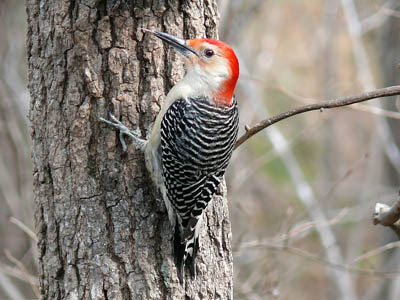 |
| Red-bellied Woodpecker Image by skeeze from Pixabay |
Red-bellied Woodpecker:
These rather large woodpeckers are frequent feeder visitors.
They live in deciduous woods throughout the eastern United States. Here is another example of a species in Michigan that is common year-round on most of the Lower Peninsula, absent from the Upper Peninsula and northern parts of the Lower Peninsula.
Fairly large and stock with a large head and long chisel-shaped bill. They have stiff, short, pointed tail feathers that they use to prop themselves up as they climb the tree trunk.
They give a churrr call.
Red-bellied Woodpeckers visit feeders for nuts, sunflower seeds, and suet.
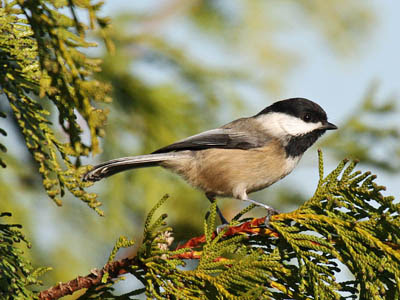 |
| Black-capped Chickadee Photo by Greg Gillson |
Black-capped Chickadee:
These cute little birds are a favorite at northern bird feeders.
They are resident in deciduous and mixed woodlands from Alaska, across Canada, and the northern United States. These birds are resident throughout Michigan.
They are pudgy with a big round head on a short neck. The bill is small but stout. The tail is fairly long and rounded. They are generally gray above and pale buff below. The white side of the face splits the extensive black cap from the large black bib on the throat.
The song is a whistled fee-bee-bee-bee. The call is a harsh chick-a-dee-dee-dee.
Black-capped Chickadees love black oil sunflower seeds that they take from tube and hopper feeders.
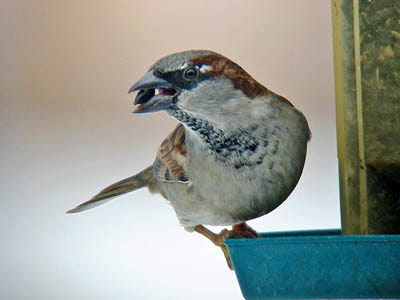 |
| House Sparrow Photo by Greg Gillson |
House Sparrow:
These city birds can be messy and aggressive when they form large flocks. A couple at a time at the feeder seems just fine to me.
They are resident wherever humans have homes and farms and towns across Canada and the United States below the high mountains. They are resident throughout Michigan.
Rather compact with large head and cone-shaped bill. Females and younger birds are colored a dusty brown above and gray below with a pale eyebrow and dark stripes on the back. In breeding plumage the male has a gray crown and black mask and bib, with chestnut back from the eye and on the wing, which has 2 white wing bars.
Calls are chirping chirrup and cheep.
House Sparrows love smaller mixed seeds such as milo, found in cheap bird seed, which few other backyard birds eat. They eat from platform feeders and hopper feeders with wide trays.
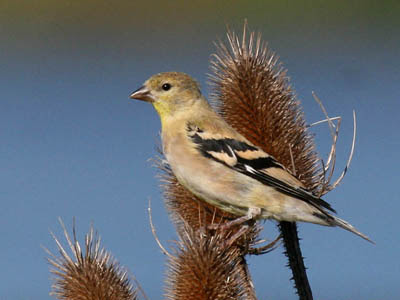 |
| American Goldfinch Photo by Greg Gillson |
American Goldfinch:
These small flocking birds visit bird feeders in small active flocks or family groups.
They breed in summer in weedy fields across southern Canada and the northern United States. In winter they move southward out of Canada and across all of the U.S. They can be found year-round in Wisconsin.
They are small and slim with a short forked tail. They have a round head and a small conical bill.
Males in summer breeding plumage are strikingly bright yellow and black.
In winter they are more dull tan with a hint of yellow on the throat. The black wings have wide white wing bars on edges of coverts and tertials. They also have white edges on the black tail feathers.
They are constantly twittering and calling to each other in the flock. One call is a whiny sweee. Flying away they sound a distinctive loud per-chick-o-ree.
American Goldfinches eat black oil sunflower seeds from tube feeders, but really like Niger seed in special “thistle sock” feeders.
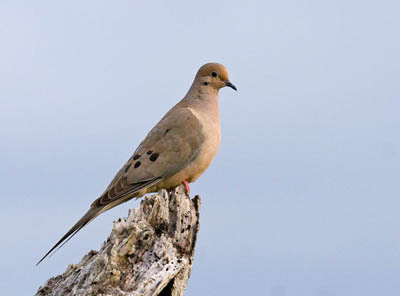 |
| Mourning Dove Photo by Greg Gillson |
Mourning Dove:
These birds are one of the most widespread and common in the United States.
In summer they are found across southern Canada and the U.S. and through Mexico. In winter, birds retreat from Canada and the northern Great Plains. In Michigan they summer and breed throughout, but are found only in the southern half of the Lower Peninsula in winter.
These are plump birds with small round heads and a long pointed tail. They have a medium-long thin bill, slightly hooked. They are fawn brown above and paler pinkish below. They have black spots on the wing coverts and a small dark mark on the cheek.
Their familiar call is a mournful cooing: boo-hoo-hoo.
Mourning Doves eat all kinds of seeds including sunflower seeds, millet, and cracked corn. They prefer to feed on the ground or large platform feeders.
Setting up a winter bird feeder in Michigan
So, what bird feeder do you set up to feed birds in Michigan?
I suggest starting with a hopper feeder. All the birds listed should come to that kind of feeder. And most of the birds that use feeders in Michigan actually prefer a hopper feeder.
I suggest a larger feeder because such may have a large roof to keep off the snow in winter.
As for bird seed, I would start with a premium blend that has about half black oil sunflower seed and then a good amount of white proso millet. Please skip the inexpensive bird seed that is mostly milo filler than most birds do not like.
I recently bought Wagner’s Songbird Supreme. It has a great combination of seeds. See if you can find it or something like it as to ingredients listed and ratio.
A suet feeder will attract woodpeckers and nuthatches, chickadees, and titmouses, among others.
Finally, you may consider setting up a bird bath. Birds need fresh water in winter when natural sources are frozen. Thus, you may want a bird bath with a heater.
Wrapping Up
Michigan winters offer a true test of survival for its feathered residents. But these clever birds have developed a remarkable array of adaptations and behaviors to cope with the harsh conditions:
Weathering the Cold:
- Feathers: Their primary layer of defense, fluffy down feathers provide excellent insulation, trapping air and conserving body heat. Some species even grow an extra layer of down in winter.
- Counter-current heat exchange: This ingenious system minimizes heat loss in extremities like legs and feet. Blood flowing to cold extremities warms up against returning cold blood, preventing precious heat from escaping.
- Shivering: While less effective than in mammals, birds do shiver to generate heat, especially when perched still.
- Huddling: Small birds like chickadees huddle together at night to share body heat and conserve energy.
Finding Food:
- Dietary Shift: Many birds switch to high-fat diets in winter, as fats provide more energy per gram than carbohydrates or proteins. Seeds, nuts, and suet cakes are popular winter feasts.
- Caching: Some birds like jays and nutcrackers gather and hide food during fall, creating a hidden pantry to access during lean winter months.
- Adapting to new sources: While insects become scarce, some birds switch to berries, fruit, or even scavenge human scraps to survive.
Other Winter Adaptations:
- Duller Plumage: Some birds lose their vibrant summer colors, gaining duller or streaked plumage in winter. This can offer camouflage against predators in the snow and bare branches.
- Decreased Activity: Birds move less in winter to conserve energy, often only venturing out to find food and shelter.
- Migration: Many bird species, particularly warblers and thrushes, migrate south to escape the harsh winter conditions and find abundant food sources.
Frequently Asked Questions
Which birds stay in Michigan during the winter?
Many feathered friends choose to stick around Michigan during the colder months, showcasing their impressive adaptations to the harsh winter conditions. Here are some common residents you might encounter:
Black-capped Chickadees: These charming little bundles of fluff with their iconic “chick-a-dee-dee” call readily visit feeders and flit through woodlands, adding a cheerful presence to winter landscapes.
Northern Cardinals: The vibrant red males and brown females are a beautiful reminder of life during winter, often seen in backyards and woodlands, brightening snowy scenes with their crimson plumage.
Blue Jays: These loud and intelligent birds with their striking blue plumage readily visit feeders for nuts, seeds, and suet, adding a lively presence to winter gardens.
Downy and Hairy Woodpeckers: These industrious birds tap away at trees in search of insects and sap, adding a drumming rhythm to the winter air, even beneath a blanket of snow.
White-breasted Nuthatches: These acrobatic climbers readily visit feeders and hop along branches, searching for nuts and seeds with their distinctive “yank-yank” call.
American Crows: These intelligent and social birds flock together in winter, offering a mesmerizing sight against the winter sky.
Where can I find a Snow Bunting in Michigan?
Snow Buntings are fascinating winter visitors to Michigan, gracing the state with their distinctive white plumage and lively chirps. However, finding them can be a bit of a challenge, as they prefer specific habitats and can be quite mobile. Here are some tips to increase your chances of spotting a Snow Bunting in Michigan:
Habitat:
- Open fields: Look for Snow Buntings in flat, open areas like agricultural fields, grasslands, and airports. They spend a lot of time on the ground, searching for seeds and grains.
- Shorelines: Coastal areas, beaches, and lake shores can attract Snow Buntings, especially during windy weather when they seek shelter from the wind.
- Gravel pits and quarries: These open, sparsely vegetated areas can be suitable foraging grounds for Snow Buntings.
Timing:
- Winter months: Snow Buntings arrive in Michigan in late November or early December and usually stay until March or April. Peak viewing times are generally January and February.
- Daytime: They are most active during the day, so plan your search for morning or afternoon hours.
- Cold and windy days: Snow Buntings tend to be more active and visible when the weather is cold and windy, as they forage for food more vigorously.
Related Articles:
The most common backyard birds in Michigan
Birds at your feeder in Michigan
Red, Orange, & Yellow birds of Michigan
My recommended bird feeder setup






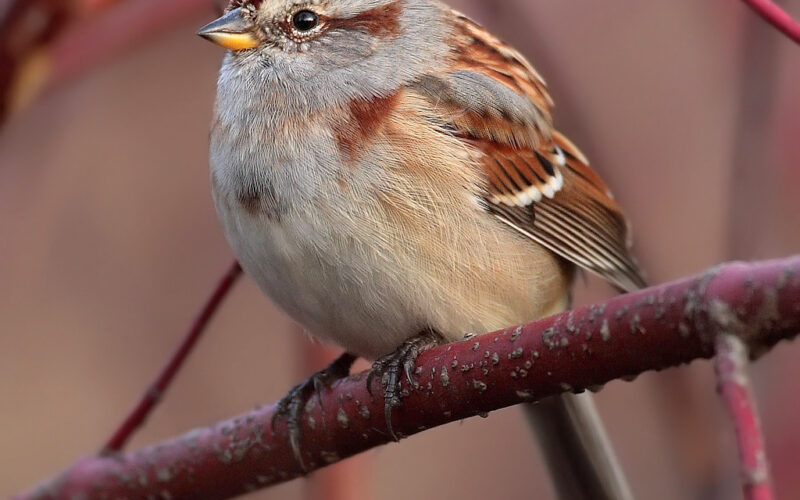
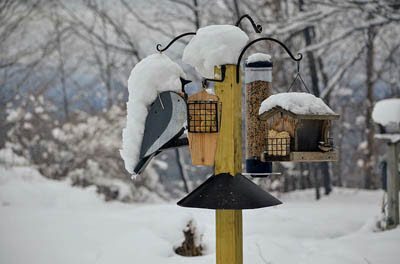




your mom